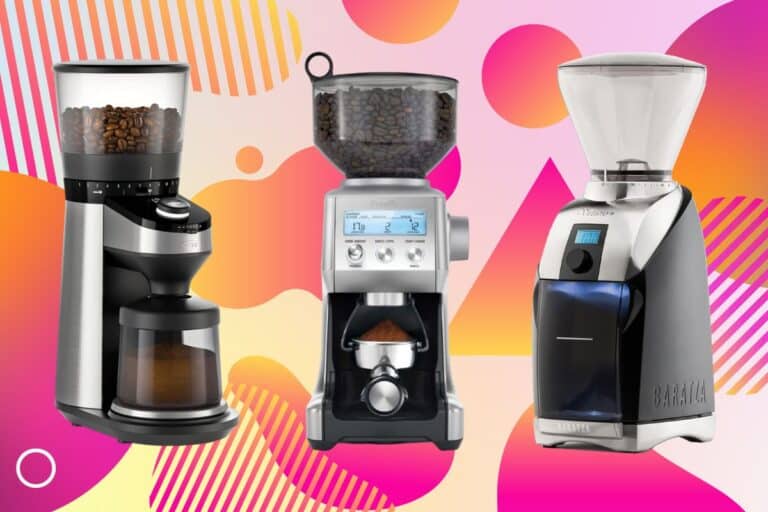Coffee, a beverage that has become a universal daily ritual, a conversation starter, a source of comfort, and a jumpstart to many mornings across the globe. It’s much more than just a drink – it’s a culture, an economy, an art, a science, and for some, a passion.
In this comprehensive guide, we will embark on a journey through the rich and complex world of coffee. From its origins to its diverse preparation styles, from beans to brew, we’ll explore the ins and outs of this captivating drink, hoping to provide both the novice and the seasoned coffee enthusiast with valuable insights into what makes each cup of coffee unique and delightful.
Coffee holds an essential role in our society today. Economically it’s one of the most valuable traded commodities in the world, second only to oil. Culturally, coffee has shaped and continues to shape customs, routines, and social interactions across different societies. It has its own rituals, spawned thriving industries, and has even influenced significant historical events.
Coffee is a brewed drink prepared from roasted coffee beans, the seeds of berries from certain Coffea species. The genus Coffea is native to tropical regions of Africa, specifically Ethiopia and Sudan, and Madagascar, the Comoros, Mauritius, and Réunion in the Indian Ocean.
The history of coffee dates back to the 15th century, and possibly earlier with a number of reports and legends surrounding its first use. The story that has stuck told of a shepherd named Kaldi who noticed his goats didn’t want to sleep at night after eating berries from a certain tree. A monk then made a drink with the berries and found it kept him awake at night, thus the original cup of coffee was born.
Today, coffee plants are cultivated in over 70 countries, primarily in the equatorial regions of the Americas, Southeast Asia, India, and Africa. Once ripe, coffee berries are picked, processed, and dried to yield the seeds inside. The seeds are then roasted to varying degrees, depending on the desired flavor, before being ground and brewed to produce coffee.
Throughout this guide, we will explore the entire coffee process, shedding light on why your morning brew tastes the way it does, and how you can make the most of your coffee drinking experience. Let’s dive in!
Understanding Coffee: The Basics
Coffee has become such an integral part of our lives, yet many of us are unaware of the journey it takes from seed to cup. The coffee plant, its species, the regions it’s grown in, and the process of coffee production all greatly influence the flavors we enjoy in our daily brew.
Explanation of Coffee Plant: Arabica and Robusta

There are over 120 species of Coffea plants, but the two most commercially important species are Coffea Arabica (Arabica) and Coffea Canephora (Robusta).
Arabica coffee trees are delicate plants that require careful cultivation in higher altitudes, with ideal growing conditions being under the shade, and temperatures between 15-24°C. They produce a finer, more aromatic, and flavorful coffee, which is preferred by most specialty coffee drinkers. Arabica beans have a milder, more sophisticated flavor, with notes of sugar, fruit, and berries, along with a higher acidity.
Robusta, on the other hand, is a hardier plant that can grow at lower altitudes and resist diseases better. It produces a strong, full-bodied coffee with a distinct, earthy flavor, significantly more bitter than Arabica, with twice the caffeine content. Robusta is often used in blends and instant coffee due to its higher yield and lower production costs.
Coffee Growing Regions Around the World
Coffee thrives in the region known as “The Coffee Belt,” which encompasses the area between the Tropics of Cancer and Capricorn. The unique climate conditions in this region – consistent temperatures, regular rainfall, and high altitude – provide the perfect environment for coffee cultivation. Major coffee-producing regions include Central and South America (notably Brazil and Colombia), Africa (primarily Ethiopia and Kenya), and Asia (Vietnam and Indonesia). Each region has distinct soil, weather, and cultivation practices, all contributing to the unique profiles of their coffee.
The Process of Coffee Production: From Bean to Cup
The journey of coffee from bean to cup is a complex and labor-intensive process. It starts with the planting of coffee seeds in large beds. When the seedlings are mature, they are transplanted to the field, where they take three to four years to bear fruit, known as coffee cherries.
The harvested cherries then undergo processing, which can be “dry” or “wet”. The dry method, also known as natural processing, involves drying the cherries in the sun before the beans are extracted. This method imparts a sweet, fruity character to the beans. The wet method, or washed processing, removes the pulp from the cherry before the beans are dried. This method results in a clean, bright flavor.
Once dried, the green coffee beans are sorted and graded. They are then roasted at high temperatures, during which the beans darken, and the characteristic coffee flavor emerges. The roasting process is integral to the taste of coffee – darker roasts result in a stronger, bolder flavor, while lighter roasts allow the bean’s natural flavors and acidity to shine.
The final steps include grinding the beans and brewing the coffee. The size of the grind should match the brewing method to extract the best flavor. Coffee can be brewed using a variety of methods, each resulting in a distinct flavor profile.
Throughout this guide, we will delve deeper into each of these topics, providing a comprehensive understanding of the incredible journey of coffee from bean to cup.
Different Types of Coffee Beans
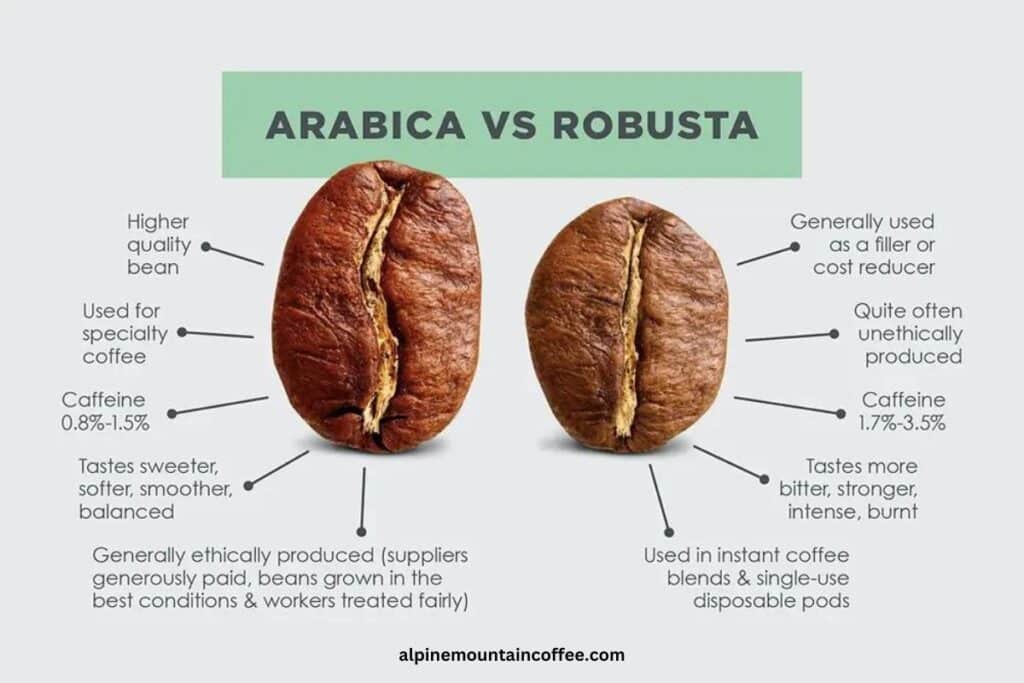
Although coffee beans come in a variety of types, each with its own characteristics, the two most widely grown and consumed are Arabica and Robusta. Other less common types also add to the richness of the coffee world. In this section, we delve deeper into these coffee beans, their origins, taste profiles, and other unique attributes.
Arabica Coffee: Origin, Taste Profile, and Characteristics
Arabica, scientifically known as Coffea arabica, is the most popular type of coffee worldwide, accounting for about 60-70% of global production. Originating from the southwestern highlands of Ethiopia, Arabica coffee is now grown in various parts of the world, including Latin America, East Africa, Asia, and Arabia.
Arabica beans are generally oval-shaped and slightly curved with a crease down the middle. They are known for their delicate, complex flavors and lower caffeine content compared to Robusta. Depending on where they’re grown, Arabica beans can have a wide variety of taste profiles, from sweet and soft to sharp and tangy. Common flavor notes include sugar, fruit, berries, and wine.
Robusta Coffee: Origin, Taste Profile, and Characteristics
Robusta, or Coffea canephora, is the second most popular type of coffee. It is believed to have originated in sub-Saharan Africa and is now mostly grown in Africa, Indonesia, Vietnam, and Brazil.
Robusta beans are round and smaller than Arabica beans, and have a straight crease down the middle. They have almost double the caffeine content of Arabica, making the taste more bitter, with a heavy body and grainy texture. The taste profile of Robusta is often described as woody, earthy, or having a peanutty aftertaste.
Other Less Common Types of Coffee Beans
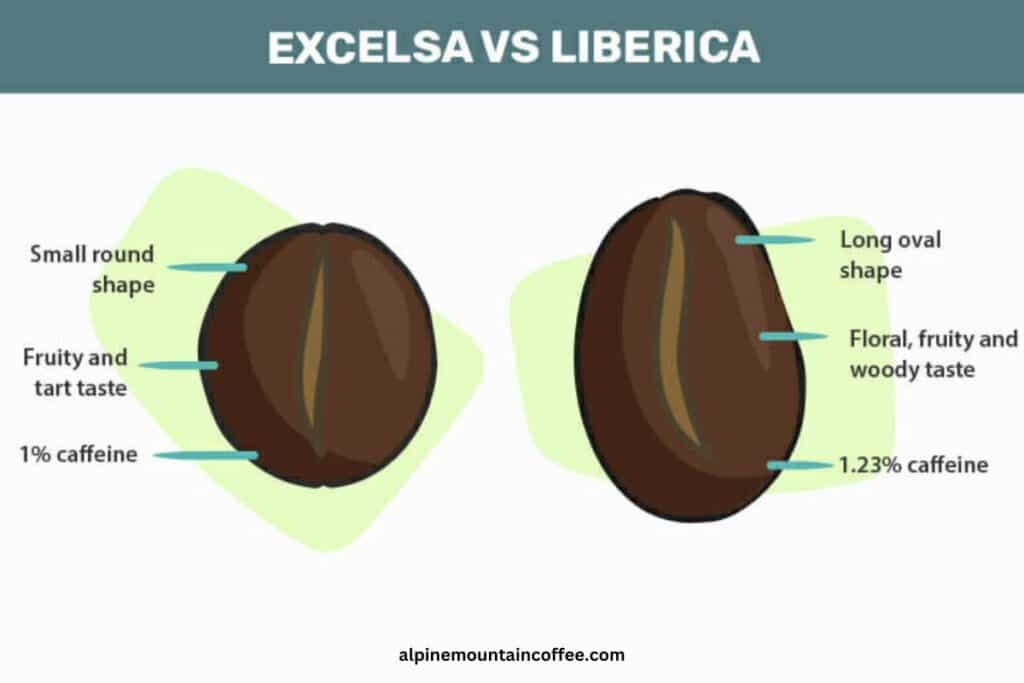
Beyond Arabica and Robusta, there are several other less common types of coffee beans that coffee lovers should be aware of:
- Liberica: Coffea liberica, native to western and central Africa, has larger beans and a distinct, fruity, and floral flavor profile. Its trees are highly resistant to diseases, but it only makes up a small percentage of the world’s coffee production.
- Excelsa: Often classified as a member of Liberica species, Excelsa has its unique characteristics and flavor profiles. It grows on large trees mostly in Southeast Asia, contributing to less than 1% of the world’s coffee. Excelsa is known for its tart, fruit-like taste and its complex flavor.
Comparison between Coffee Beans
While Arabica is known for its smooth, slightly acidic taste profile and lower caffeine content, Robusta is more robust, with a harsher taste and higher caffeine content. Arabica beans are more expensive than Robusta due to their preferred taste and the fact that Arabica plants are more prone to disease and harder to cultivate.
Less common beans, such as Liberica and Excelsa, offer unique flavors, but their availability and price can vary greatly depending on the location and specific market conditions. As coffee lovers continue to explore, appreciate, and demand a variety of tastes, these beans add interesting and rich dimensions to the world of coffee.
Coffee Roasting and Its Effect on Flavor
Coffee roasting is a crucial step in the journey from bean to cup. It is an art form as much as it is a science, and the way coffee beans are roasted dramatically impacts the flavor, aroma, and overall character of your coffee.
Introduction to Coffee Roasting
Coffee roasting is a heat process that transforms the chemical and physical properties of green coffee beans into roasted coffee products. The roasting process is what produces the characteristic flavor of coffee by causing the green coffee beans to expand and to change in color, taste, smell, and density. This process entails a series of chemical reactions that unlock the complex flavors hidden inside the raw, green bean.
Different Levels of Roasting: Light, Medium, Dark
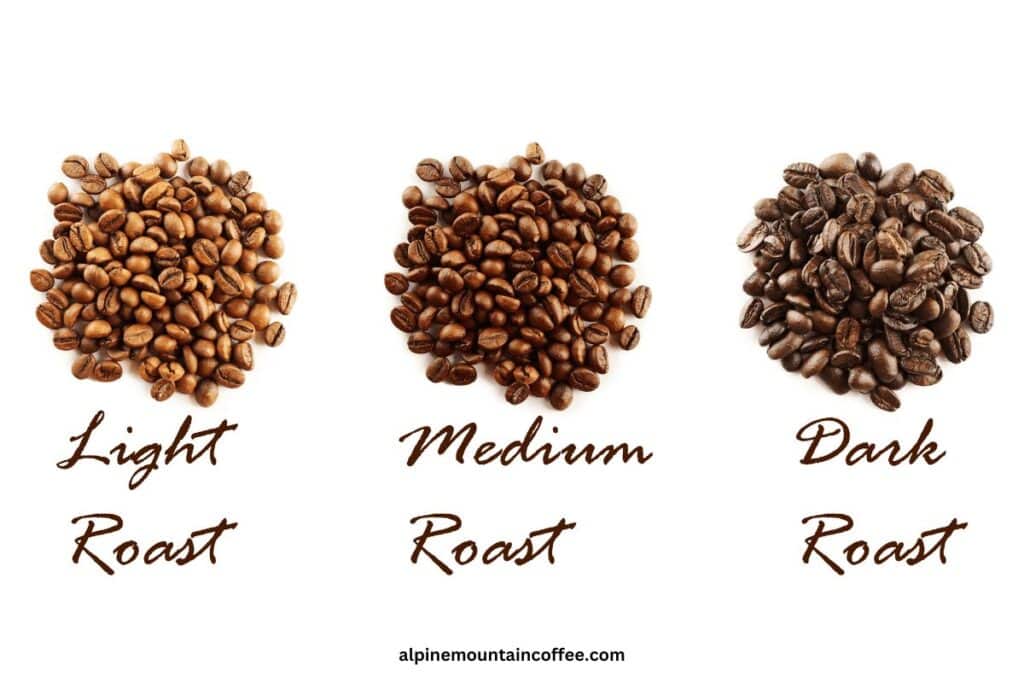
There are different levels of roasting, and each has a significant impact on the final taste of the coffee:
- Light Roasts: Also known as ‘cinnamon roast’, ‘half city’, or ‘New England roast’, the beans are roasted to a light brown color, and there’s no oil on the surface of the beans. Light roasts have a toasted grain taste and pronounced acidity, showcasing the coffee’s inherent flavors, also known as ‘origin character’.
- Medium Roasts: Also known as ‘city roast’ or ‘American roast’, the beans are roasted to a medium brown color with a stronger flavor and a non-oily surface. They offer a balanced flavor, aroma, and acidity.
- Dark Roasts: This includes ‘French roast’, ‘Italian roast’, and ‘espresso roast’. The beans are roasted to a shiny, dark brown color with an oily surface. Dark roasts have a pronounced bitterness, and the darker the roast, the less acidity will be found in the coffee.
How Roast Level Affects Flavor, Aroma, and Caffeine Content
The roast level has a profound impact on the coffee’s flavor, aroma, and even caffeine content. Lighter roasts allow the unique flavors of the coffee’s origin to shine through, whereas darker roasts tend to bring out the flavors created in the roasting process itself.
A common misconception is that darker roasts have more caffeine. In reality, the caffeine content slightly decreases during the roasting process, so light roasts could have a little more caffeine than their darker counterparts, although the difference is minimal.
Popular Coffee Roasting Styles Around the World
Different regions around the world have developed unique roasting styles:
- Italian Roast: Used primarily for espresso, the beans are roasted to a dark color, giving a rich, bold, and slightly bitter taste.
- French Roast: The beans are double-roasted resulting in a dark roast with a heavy body and strong, bold flavors.
- Scandinavian Roast: Common in Nordic countries, it’s a very light roast that helps maintain the coffee’s original flavors and high acidity.
The world of coffee roasting is complex and fascinating, offering endless opportunities to manipulate and experiment with flavor profiles. Each roasting level unlocks a different flavor combination, allowing for a vast array of experiences in every cup.
Different Coffee Brewing Methods

The method used to brew coffee plays an essential role in the resulting flavor and strength of the coffee. There are many brewing methods to choose from, each offering a unique taste and experience.
Drip Coffee
Drip coffee or filter coffee is one of the most popular brewing methods, especially in North America. It involves pouring hot water over a filter containing ground coffee, which then drips into a carafe or cup. This method produces a clean taste, as the paper filter traps most of the coffee’s oils and sediments.
Espresso
Espresso is a method of brewing coffee by forcing a small amount of nearly boiling water under pressure through finely-ground coffee beans. It forms the basis for many coffee drinks like lattes and Cappuccinos. It is strong, concentrated, and has a thicker consistency compared to other brew methods.
French Press
The French Press or press pot is a full immersion brewing method. Ground coffee is steeped in hot water before being separated by pressing down a metal filter. This method allows the coffee to maintain its natural oils, resulting in a robust, full-bodied brew.
Cold Brew
Cold brew is made by steeping coarse coffee grounds in cold water for an extended period, typically 12 to 24 hours. The result is a smooth, well-rounded, and less acidic brew that can be served over ice or used as a base for other drinks.
Pour Over
In the Pour Over method, water is manually poured over coffee grounds in a filter, allowing the coffee to seep through the filter into a carafe or mug. It offers control over the brewing process and highlights the nuanced flavors of the coffee, resulting in a clean and vibrant brew.
AeroPress
The AeroPress is a device for brewing coffee that uses air pressure to force water through the coffee grounds. This method is fast, simple, and versatile, yielding a smooth, rich, and full-bodied cup with lower acidity.
Percolator
A percolator continually cycles the boiling brew through the coffee grounds using gravity until the desired strength is reached. This method is popular for making strong, often bitter coffee and is more commonly used for large batches.
Moka Pot
The Moka Pot is a stove-top or electric coffee maker that brews coffee by passing boiling water pressurized by steam through ground coffee. It produces a rich, strong coffee similar to espresso.
Turkish Coffee
Turkish coffee is made by boiling finely ground coffee beans in a pot (cezve), with sugar if desired, and served where the grounds are allowed to settle. It’s a strong, unfiltered method of brewing with a full-bodied, robust, and unique flavor.
Popular Coffee Drinks Around the World
Coffee transcends cultures, and each country has developed unique ways to enjoy it. Whether it’s an Italian espresso or a frothy Greek Frappe, let’s explore the variety of coffee drinks from around the world.
Espresso-Based Drinks

Espresso-based drinks are a popular category of coffee beverages that are made using a shot or shots of espresso as the base ingredient. These drinks are typically prepared by combining espresso with various amounts of steamed milk, frothed milk, or other ingredients to create a wide range of flavors and textures. Here are some commonly known espresso-based drinks:
- Espresso: Espresso is a concentrated form of coffee made by forcing hot water through finely ground coffee beans under high pressure. It is typically served as a single or double shot and forms the base for many other espresso-based drinks.
- Espresso Macchiato: Espresso Macchiato is a shot of espresso “marked” with a small amount of frothed milk or milk foam. The milk is added to “stain” or “mark” the espresso, resulting in a bolder flavor than a regular espresso shot.
- Espresso Con Panna: Espresso Con Panna is a shot of espresso topped with a dollop of whipped cream. The name “Con Panna” means “with cream” in Italian. It adds a rich and creamy element to the strong espresso.
- Caffé Latte: Caffé Latte is a popular espresso-based drink made with a shot of espresso and steamed milk. It usually has a higher ratio of milk to espresso, resulting in a creamy and smooth taste. It may also be topped with a small layer of milk foam.
- Flat White: Flat White is a coffee drink that originated in Australia or New Zealand. It consists of a double shot of espresso combined with a small amount of steamed milk. The key difference from a latte is that it has less milk, resulting in a stronger coffee flavor and a velvety texture.
- Café Breve: Café Breve is a variation of a latte made with half-and-half (half milk and half cream) instead of just milk. The use of cream instead of milk creates a richer and creamier texture, giving the drink a more indulgent taste.
- Cappuccino: Cappuccino is an espresso-based drink made with equal parts espresso, steamed milk, and milk foam. It is typically served in a small cup and is known for its distinct layers: a bottom layer of espresso, a middle layer of steamed milk, and a top layer of milk foam.
- Caffé Mocha: Caffé Mocha, also known as a Mocha, is a combination of espresso, steamed milk, and chocolate. It is often made with a shot of espresso, chocolate syrup or powder, and topped with whipped cream. It offers a delightful blend of rich coffee flavor and sweet chocolate.
- Americano: An Americano is an espresso-based drink that is made by diluting one or more shots of espresso with hot water. It resembles regular brewed coffee but has a stronger flavor due to the espresso base. The ratio of espresso to water can vary based on personal preference.
Other Coffee Drinks
There are numerous coffee-based drinks beyond the espresso family:
- Irish Coffee: A cocktail consisting of hot coffee, Irish whiskey, sugar, and topped with a layer of cream.
- Affogato: An Italian dessert typically consisting of a scoop of vanilla gelato or ice cream topped with a shot of hot espresso.
- Vienna Coffee: A traditional Austrian coffee drink made by topping two shots of espresso with whipped cream.
Unique Regional Coffee Drinks
Certain regions have their unique spins on coffee:
- Vietnamese Iced Coffee (Ca Phe Sua Da): A unique blend of dark roast coffee dripped from a small metal French drip filter (phin) into a cup containing about a quarter to a half as much sweetened condensed milk, then stirred and poured over ice.
- Greek Frappe: A foam-covered iced coffee drink made from spray-dried instant coffee. It’s a popular summer beverage in Greece.
Coffee Culture and Coffee Houses
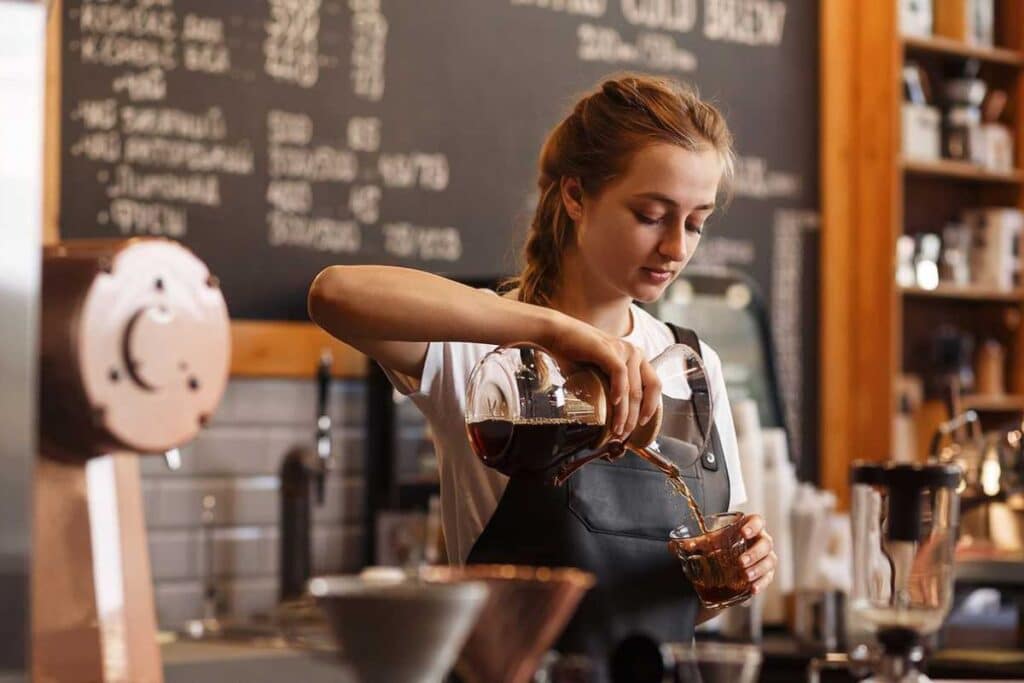
The culture surrounding coffee is as rich and varied as the drink itself. Coffee houses have played a significant role in this culture, acting as social hubs and influencing societies in profound ways.
The Rise of Coffee Houses: From Ottoman Empire to Modern-Day Starbucks
The coffee house tradition started in the Ottoman Empire in the 15th century, where coffee was a central part of socializing. This trend spread to Europe in the 17th century, where coffee houses became venues for exchanging ideas, conducting business, and discussing politics.
Fast forward to the 20th century, Starbucks capitalized on this tradition, reinventing the concept for a modern consumer society. Today, with thousands of stores worldwide, Starbucks and other global chains have made the coffee house a ubiquitous feature of urban life.
How Coffee Houses Have Influenced Societies and Cultures
Throughout history, coffee houses have been more than just places to enjoy a cup of coffee. They’ve acted as meeting places, offices, and platforms for political and philosophical discussions. For instance, in the Age of Enlightenment, coffee houses in Europe became known as “penny universities” due to the rich intellectual conversations one could participate in for the price of a cup of coffee.
Differences in Coffee Culture Around the World
Coffee culture varies widely across the globe, reflecting regional tastes, historical influences, and social attitudes. In Italy, coffee is often enjoyed quickly at the bar counter, while in Sweden, ‘fika’—a coffee break that more about socializing than the drink itself—is a cornerstone of national culture. Meanwhile, in countries like Australia and New Zealand, there’s a strong emphasis on artisanal coffee-making and specialty cafes.
The Third-Wave Coffee Movement and Specialty Coffee Shops
The third-wave coffee movement represents a shift towards viewing coffee as an artisanal product, much like wine, rather than a commodity. This movement emphasizes aspects such as quality, sustainability, and fair trade, aiming to improve every stage of production, from planting and harvesting to processing, roasting, and brewing.
Specialty coffee shops, often independently owned, are a significant part of this movement. These establishments focus on the quality and origin of their beans, and their baristas are highly trained in the art of coffee making. This movement has led to a greater appreciation for the complexity of coffee and has taken the coffee house tradition in new and exciting directions.
Conclusion

From the humble coffee bean to the bustling coffee houses that span the globe, the world of coffee is rich and complex, offering a wealth of flavors, brewing methods, and cultural experiences.
This guide has journeyed through the various types of coffee beans, the importance of roasting and its impact on flavor, the array of brewing methods, the variety of coffee drinks enjoyed around the world, and the role of coffee houses in shaping our societies and cultures. Each element adds to the tapestry of coffee, a simple beverage that has become a global phenomenon.
Understanding coffee is not merely about appreciating a beverage; it’s about appreciating a culture, a craft, and the story that every cup of coffee tells. From the farmer who harvests the coffee cherries to the barista who crafts the perfect latte, each step involves care, knowledge, and a passion for excellence.
We encourage you, the reader, to explore your coffee preferences. Try different beans, experience various brewing methods, taste coffee drinks from diverse cultures. Each cup you drink is a new adventure, a chance to explore flavors, aromas, and experiences. Let the world of coffee open up to you, and take pleasure in the journey it offers. After all, coffee is more than a beverage—it’s an exploration of cultures, a testament to craftsmanship, and a daily comfort enjoyed by millions.
